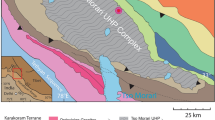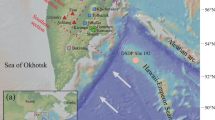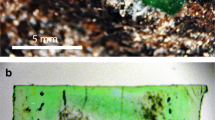Abstract
Arising from: A. Camacho, J. K. W. Lee, B. J. Hensen & J. Braun Nature 435, 1191–1196 (2005); Camacho et al. reply.
The mechanisms by which mafic rocks become converted to denser eclogite in the lower crust and mantle are fundamental to our understanding of subduction, mountain building and the long-term geochemical evolution of Earth. Based on larger-than-expected gradients in argon isotopes, Camacho et al.1 propose a new explanation — co-seismic injection of hot (700 °C) aqueous fluids into much colder (400 °C) crust — for the localized nature of eclogite metamorphism during Caledonian crustal thickening, as recorded in the rocks of Holsnøy in the Bergen arcs, western Norway. We have studied these unusual rocks2,3,4, which were thoroughly dehydrated under granulite facies conditions during a Neoproterozoic event (about 945 million years (945 Myr) ago); we also concluded that fracture-hosted fluids were essential as catalysts and components in the conversion to eclogite about 425 Myr ago5. However, we are sceptical of the assertion by Camacho et al. that eclogite temperatures were reached only in the vicinity of fluid-filled fractures. Determining whether these rocks were strong enough to fracture at depths of 50 km because they were cold or because they were very dry is crucial to understanding the mechanics of the lower crust in mountain belts, including, for example, the causes of seismicity in the Indian plate beneath the modern Himalayas6.
Similar content being viewed by others
References
Camacho, A., Lee, J. K. W., Hensen, B. J. & Braun, J. Nature 435, 1191–1196 (2005)
Austrheim, H. & Griffin, W. Chem. Geol. 50, 267–281 (1985).
Jamtveit, B., Austrheim, H. & Malthe-Sorensen, A. Nature 408, 75–78 (2000).
Austrheim, H. & Boundy, T. Science 265, 82–83 (1994).
Bjørnerud, M., Austrheim, H. & Lund, M. J. Geophys. Res. 107, 2252–2269 (2002).
Jackson, J. A., Austrheim, H., McKenzie, D. & Priestly, K. Geology 32, 625–628 (2004).
Mackwell, S., Zimmerman, M. & Kohlstedt, D. J. Geophys. Res. 103, 975–984 (1998).
Rubey, D. in Deformation Processes in Minerals, Ceramics, and Rocks (eds Barber, D. & Meredith, P.) 262–295 (Chapman and Hall, New York, 1990).
Author information
Authors and Affiliations
Rights and permissions
About this article
Cite this article
Bjørnerud, M., Austrheim, H. Hot fluids or rock in eclogite metamorphism?. Nature 440, E4 (2006). https://doi.org/10.1038/nature04714
Published:
Issue Date:
DOI: https://doi.org/10.1038/nature04714
- Springer Nature Limited
This article is cited by
-
Fluid characteristics of retrogressed eclogites and mafic granulites from the Cambrian Gondwana suture zone in southern India
Contributions to Mineralogy and Petrology (2010)
-
Geochronology of fluid-induced eclogite and amphibolite facies metamorphic reactions in a subduction–collision system, Bergen Arcs, Norway
Contributions to Mineralogy and Petrology (2008)
-
Hot fluids or rock in eclogite metamorphism? (Reply)
Nature (2006)





